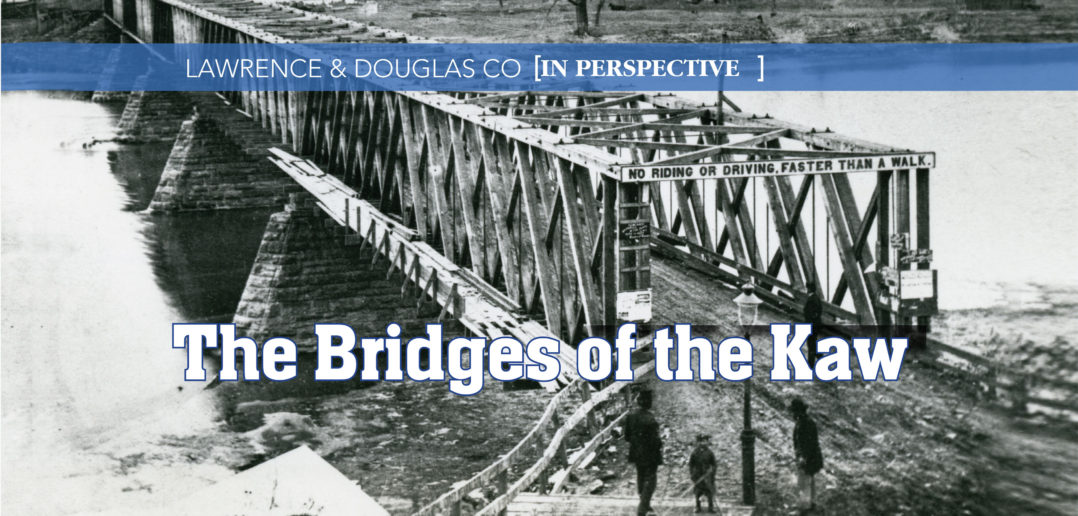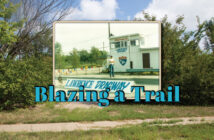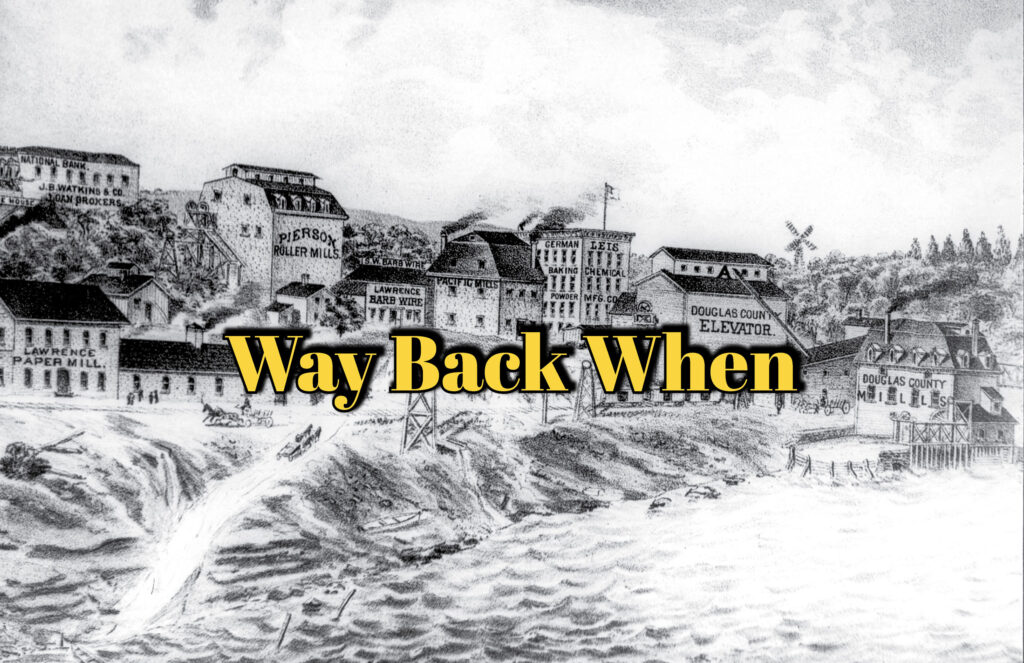| story by | |
| photos | Douglas County Historical Society, Watkins Museum of History |
Through the years, many bridges were built and brought down in one way or another in Lawrence, but their importance to the city’s infrastructure and historical value remain.
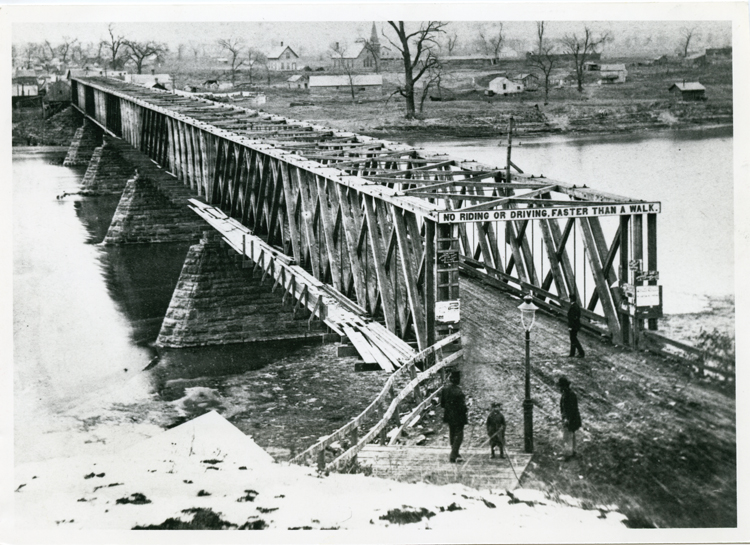
The Bridges of the Kaw
The city of Lawrence was founded in 1854 by abolitionists who came to Kansas under the auspices of the New England Emigrant Aid Company (NEEAC). The passage of the Kansas-Nebraska Act called for the slave or free status of the new territories to be decided by popular sovereignty, meaning a vote of residents would determine whether slavery would be allowed. Thus, Lawrence is one of the few cities founded primarily for political reasons. However, the founders also wanted Lawrence to be a prosperous community and locating on a river was a key to success in the 19th century. Samuel Clarke Pomeroy wrote to Amos Lawrence Sept. 22, 1854, telling him there was a consensus to name the new city after him. Lawrence was one of the financial supporters of the NEEAC. Pomeroy also provided the following description of activities in the area:
- Our people are stacking Hay and making preparations for winter as fast as they can. Some will succeed and do well, others will fail. The grass upon our prairie is still green and will yield from two to three Tons of Hay per Acre. And of good quality. There are in our party about twenty yoke of oxen—some cows—and horses also. Our Mill is being built upon a little ravine about six rods from the Bank of the Kansas, a good site. Opposite the Mill, upon the Land of the Delawares is the Largest Tract of Wood Land I have seen in the Territory. ¬—At the suggestion of Dr. Doy I have made a bargain with the Indian Chief—approved by the Indian Agent, to take Saw logs of them, cut & delivered upon the bank of the River, opposite the Mill—for 37½ cents each. Logs to be large and from 12 to 16 feet long.
This quote illustrates the importance of locating on the river to power the sawmill but also the value of the timber on the other side of the Kansas River. Since there was no bridge, it is assumed the logs were either carried by barges or floated to the south side of the river. In fact, barges and ferries were used to cross the river until the first bridge over the Kansas River was built.
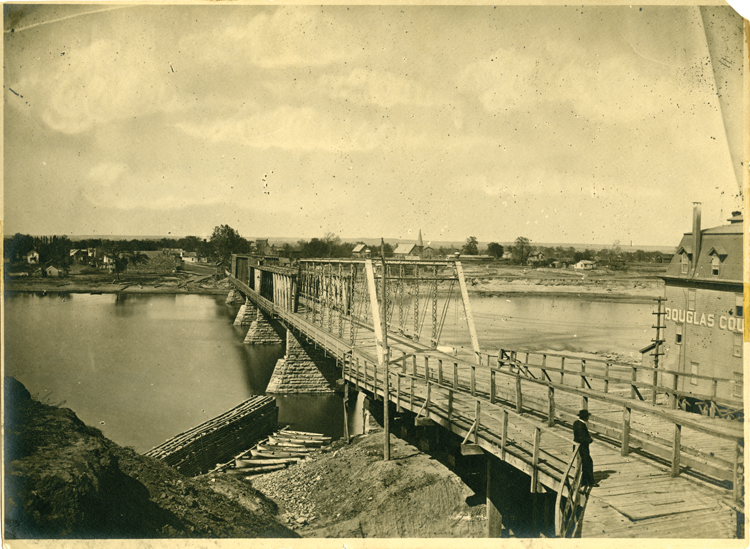
The Bridges of the Kaw
The Territorial Legislature approved a charter for the Lawrence Bridge Company in 1859. Construction began in 1863, and the bridge was completed later that year in December. The Daily Kansas Tribune celebrated the opening of the bridge in an article published Dec. 17, 1863:
- Lawrence—Its Prospects and Future
- The completion of the bridge across the Kansas river at this point, and the early completion of the Eastern Division of the Union Pacific Railroad, with the Leavenworth Branch, puts our city on a basis of material prosperity far in advance of any other town in the State. Though Lawrence suffered a terrible blow by Quantrill’s raid—a crime more terrific, inhuman and bloody, than any of the numberless crimes committed by the Southern demons in all the records of the rebellion—yet her surviving citizens have nobly braved the hours of our tribulation, and have shown an energy and a recuperative power truly magical and worthy of all praise.
It is important to realize that the railroad depot was located on the north side of the river, so a bridge was necessary to get to Lawrence proper. Also, the bridge was constructed by a private company, the Lawrence Bridge Company. To make a profit, the bridge they built was operated as a toll bridge. The first bridge was a Howe Truss design and consisted of five wooden spans resting on solid stone pieces. It was 690 feet long and cost $47,000 to build. For many years, it was the only bridge across the Kansas River west of Kansas City, so it carried a great deal of traffic. In 1879, the Kansas Supreme Court, after cancelling the charter of the Lawrence Bridge Company, took possession of the bridge on behalf of the state.
In the fall of 1872, preliminary plans were made to build a dam to utilize the waterpower of the river. With the completion of the dam, it and the bridge were tied together in a number of natural disasters. In the spring of 1876, a freshet (a river flood from heavy rain or melted snow) took out two spans of the bridge and partially destroyed the dam. In 1903, the Kansas River flooded causing property damage, especially in North Lawrence. The flood also destroyed the Bowersox Mill on the river’s south side. The floodwaters rose to 27 feet. Since it was apparent the mill would be destroyed, estimates were made about when it would happen. This drew hundreds of Lawrence residents to view the spectacle. Eventually, the mill cracked and broke up. Flour covered the watching crowd. The entire north span was destroyed when it was struck by a house in the floodwater. A ferry operated for 24 days until the bridge was repaired. In 1913, this first bridge was considered unsafe, and construction on a second bridge began.
While the first bridge was a wooden bridge, the second one was a concrete arch bridge that was 1,026 feet long. It was built by Douglas County and opened in January 1917. The floor of the bridge was brick, and it had streetcar tracks running down the center. As the brick surface decayed, the bridge was paved over.
The worst flood in Lawrence’s history was the flood of 1951, causing damage to the city in excess of $3 million as both the Kansas and Wakarusa rivers flooded their surroundings. The actual flood levels are not accurately known for the Kansas River, as the water crested above all official flood gauges. On July 13, the crest was estimated to be 29.9 feet, more than 11 feet above flood stage. The high and fast- moving waters damaged the northern approach to the Kansas River bridge, and all of North Lawrence was under water.
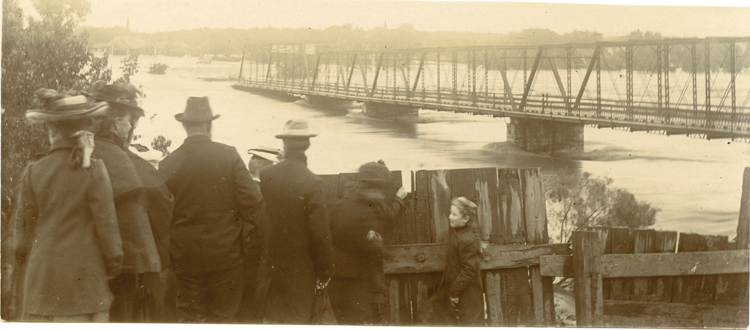
The Bridges of the Kaw
By 1972, the second bridge was deteriorating rapidly because of the daily traffic of 17,000 vehicles a day, along with damage caused by road salt and frequent patching at the south end. In 1973, the City of Lawrence and Douglas County agreed to hold a bond election to raise funds for the replacement of the bridge. The original plan was for a single four land bridge costing $3 million. Before going before the voters, the plan was changed to have a pair of two land bridges at an estimated cost of $5 million. The bond issue was approved in November 1974. Before the new bridge could be built, structural issues caused the Lawrence City Commission to impose an 8-ton load limit for traffic crossing the bridge.
Construction began on the Vermont Street bridge in April 1976. The winning bidder was at $4.5 million. Because of delays, the bridge was not completed until April 1978. It was open to two-way traffic until the Massachusetts Street bridge was completed. It was demolished, and some of the material from the old bridge was used as temporary fill as the new bridge was finished. Delays again occurred, and the bridge was opened a year and a half behind schedule in March 1980. These two bridges remain in use today, with the Massachusetts Street bridge carrying northbound traffic, and southbound vehicles using the Vermont Street bridge. This shows how important bridges are to the infrastructure, industry and history of Lawrence.
![]()

